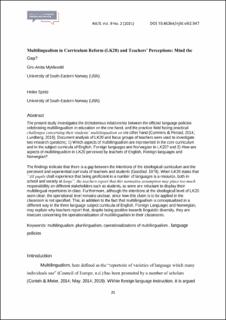| dc.contributor.author | Myklevold, Gro-Anita | |
| dc.contributor.author | Speitz, Heike | |
| dc.date.accessioned | 2022-03-21T11:24:10Z | |
| dc.date.available | 2022-03-21T11:24:10Z | |
| dc.date.created | 2022-01-24T14:17:06Z | |
| dc.date.issued | 2021 | |
| dc.identifier.citation | Myklevold, G. A., & Speitz, H. (2021). Multilingualism in Curriculum Reform (LK20) and Teachers’ Perceptions: Mind the Gap?. Nordic Journal of Language Teaching and Learning, 9(2), 25-50. | en_US |
| dc.identifier.issn | 2703-8629 | |
| dc.identifier.uri | https://hdl.handle.net/11250/2986425 | |
| dc.description.abstract | The present study investigates the dichotomous relationship between the official language policies celebrating multilingualism in education on the one hand, and the practice field facing practical challenges concerning their students’ multilingualism on the other hand (Cummins & Persad, 2014; Lundberg, 2019). Document analysis of LK20 and focus groups of teachers were used to investigate two research questions; 1) Which aspects of multilingualism are represented in the core curriculum and in the subject curricula of English, Foreign languages and Norwegian in LK20? and 2) How are aspects of multilingualism in LK20 perceived by teachers of English, Foreign languages and Norwegian?
The findings indicate that there is a gap between the intentions of the ideological curriculum and the perceived and experiential curricula of teachers and students (Goodlad, 1979). When LK20 states that “All pupils shall experience that being proficient in a number of languages is a resource, both in school and society at large”, the teachers report that this normative assumption may place too much responsibility on different stakeholders such as students, as some are reluctant to display their multilingual repertoires in class. Furthermore, although the intentions at the ideological level of LK20 seem clear, the operational level remains unclear, since how this claim is to be applied in the classroom is not specified. This, in addition to the fact that multilingualism is conceptualized in a different way in the three language subject curricula of English, Foreign Languages and Norwegian, may explain why teachers report that, despite being positive towards linguistic diversity, they are insecure concerning the operationalization of multilingualism in their classrooms. | en_US |
| dc.language.iso | eng | en_US |
| dc.relation.uri | https://journal.uia.no/index.php/NJLTL/article/view/947 | |
| dc.rights | Navngivelse-Ikkekommersiell 4.0 Internasjonal | * |
| dc.rights.uri | http://creativecommons.org/licenses/by-nc/4.0/deed.no | * |
| dc.title | Multilingualism in Curriculum Reform (LK20) and Teachers' Perceptions: Mind the Gap? | en_US |
| dc.type | Peer reviewed | en_US |
| dc.type | Journal article | en_US |
| dc.description.version | publishedVersion | en_US |
| dc.rights.holder | © 2021 Gro-Anita Myklevold. | en_US |
| dc.source.pagenumber | 25-50 | en_US |
| dc.source.volume | 9 | en_US |
| dc.source.journal | Nordic Journal of Language Teaching and Learning (NJLTL) | en_US |
| dc.source.issue | 2 | en_US |
| dc.identifier.doi | https://doi.org/10.46364/njltl.v9i2.947 | |
| dc.identifier.cristin | 1988666 | |
| cristin.ispublished | true | |
| cristin.fulltext | original | |
| cristin.qualitycode | 1 | |

